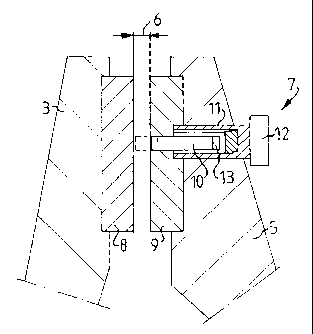Some of the information on this Web page has been provided by external sources. The Government of Canada is not responsible for the accuracy, reliability or currency of the information supplied by external sources. Users wishing to rely upon this information should consult directly with the source of the information. Content provided by external sources is not subject to official languages, privacy and accessibility requirements.
Any discrepancies in the text and image of the Claims and Abstract are due to differing posting times. Text of the Claims and Abstract are posted:
| (12) Patent: | (11) CA 2373820 |
|---|---|
| (54) English Title: | METHOD AND ARRANGEMENT FOR DISTANCE MEASUREMENT |
| (54) French Title: | PROCEDE ET DISPOSITIF DE MESURE DE DISTANCE |
| Status: | Term Expired - Post Grant Beyond Limit |
| (51) International Patent Classification (IPC): |
|
|---|---|
| (72) Inventors : |
|
| (73) Owners : |
|
| (71) Applicants : |
|
| (74) Agent: | SMART & BIGGAR LP |
| (74) Associate agent: | |
| (45) Issued: | 2009-06-02 |
| (86) PCT Filing Date: | 2001-03-20 |
| (87) Open to Public Inspection: | 2001-09-27 |
| Examination requested: | 2006-02-02 |
| Availability of licence: | N/A |
| Dedicated to the Public: | N/A |
| (25) Language of filing: | English |
| Patent Cooperation Treaty (PCT): | Yes |
|---|---|
| (86) PCT Filing Number: | PCT/SE2001/000572 |
| (87) International Publication Number: | WO 2001071276 |
| (85) National Entry: | 2001-11-09 |
| (30) Application Priority Data: | ||||||
|---|---|---|---|---|---|---|
|
In a machine which is provided with a stator and an opposite
rotor, a sensor of magnetic type, arranged in the stator, for
determining the distance between the stator and the rotor can
be calibrated by the sensor first being moved relative to the
stator into contact with the rotor for zeroing. The sensor is
then reversed a predetermined distance, after which the
sensor signal can be used for determining the distance
between the stator and the rotor. In an arrangement suitable
for the purpose, the stator has at least one sensor of
magnetic type, which is intended to interact with an opposite
surface on the rotor. The sensor is mounted displaceably in
the axial direction of the rotor and can be brought into
contact with the rotor.
L'invention concerne une machine comportant un stator (5) et un rotor opposé (3), un capteur magnétique (10) étant disposé dans le stator afin de déterminer la distance entre le stator et le rotor. Ledit capteur peut être étalonné par déplacement de ce dernier par rapport au stator, en contact avec le rotor pour la mise à zéro. Le capteur est ensuite ramené sur une distance prédéterminée, le signal du capteur pouvant ensuite être utilisé pour déterminer la distance (6) entre le stator (5) et le rotor (3). Dans un dispositif selon l'invention, le stator (5) comporte au moins un capteur magnétique (10) destiné à interagir avec une surface opposée du rotor (3). Le capteur (10) est monté de manière mobile dans le sens axial du rotor et peut être mis en contact avec le rotor (3).
Note: Claims are shown in the official language in which they were submitted.
Note: Descriptions are shown in the official language in which they were submitted.

2024-08-01:As part of the Next Generation Patents (NGP) transition, the Canadian Patents Database (CPD) now contains a more detailed Event History, which replicates the Event Log of our new back-office solution.
Please note that "Inactive:" events refers to events no longer in use in our new back-office solution.
For a clearer understanding of the status of the application/patent presented on this page, the site Disclaimer , as well as the definitions for Patent , Event History , Maintenance Fee and Payment History should be consulted.
| Description | Date |
|---|---|
| Inactive: Expired (new Act pat) | 2021-03-22 |
| Common Representative Appointed | 2019-10-30 |
| Common Representative Appointed | 2019-10-30 |
| Grant by Issuance | 2009-06-02 |
| Inactive: Cover page published | 2009-06-01 |
| Inactive: Final fee received | 2009-02-02 |
| Pre-grant | 2009-02-02 |
| Notice of Allowance is Issued | 2008-09-04 |
| Letter Sent | 2008-09-04 |
| Notice of Allowance is Issued | 2008-09-04 |
| Inactive: IPC removed | 2008-08-30 |
| Inactive: Approved for allowance (AFA) | 2008-06-12 |
| Amendment Received - Voluntary Amendment | 2008-03-04 |
| Inactive: S.30(2) Rules - Examiner requisition | 2007-09-05 |
| Inactive: IPC from MCD | 2006-03-12 |
| Inactive: IPC from MCD | 2006-03-12 |
| Letter Sent | 2006-02-14 |
| Request for Examination Received | 2006-02-02 |
| Request for Examination Requirements Determined Compliant | 2006-02-02 |
| All Requirements for Examination Determined Compliant | 2006-02-02 |
| Letter Sent | 2002-06-07 |
| Letter Sent | 2002-06-07 |
| Inactive: Cover page published | 2002-06-03 |
| Inactive: Notice - National entry - No RFE | 2002-05-28 |
| Application Received - PCT | 2002-03-27 |
| Inactive: Single transfer | 2002-01-14 |
| National Entry Requirements Determined Compliant | 2001-11-09 |
| Application Published (Open to Public Inspection) | 2001-09-27 |
There is no abandonment history.
The last payment was received on 2009-03-06
Note : If the full payment has not been received on or before the date indicated, a further fee may be required which may be one of the following
Please refer to the CIPO Patent Fees web page to see all current fee amounts.
Note: Records showing the ownership history in alphabetical order.
| Current Owners on Record |
|---|
| DAPROX AB |
| Past Owners on Record |
|---|
| BENGT AKERBLOM |